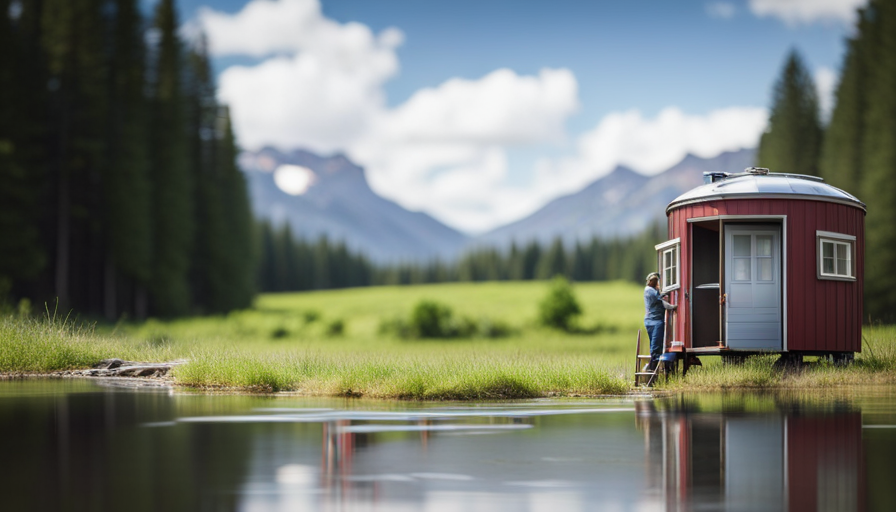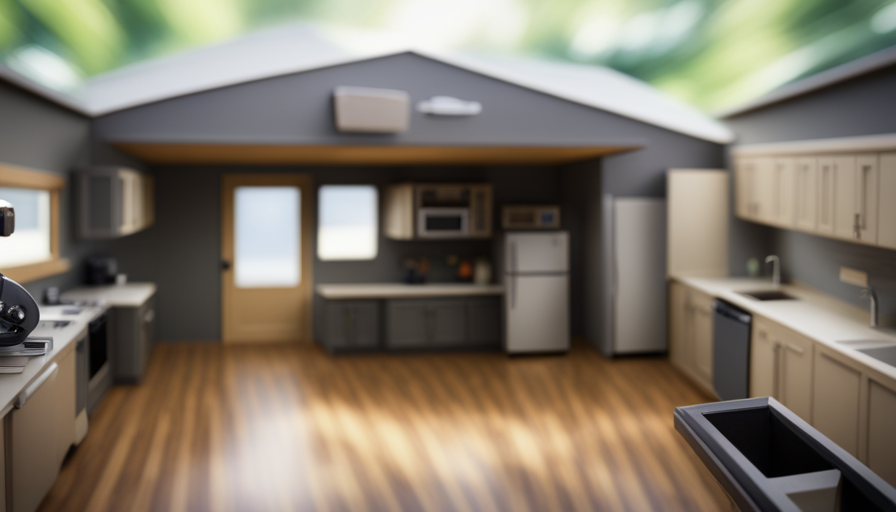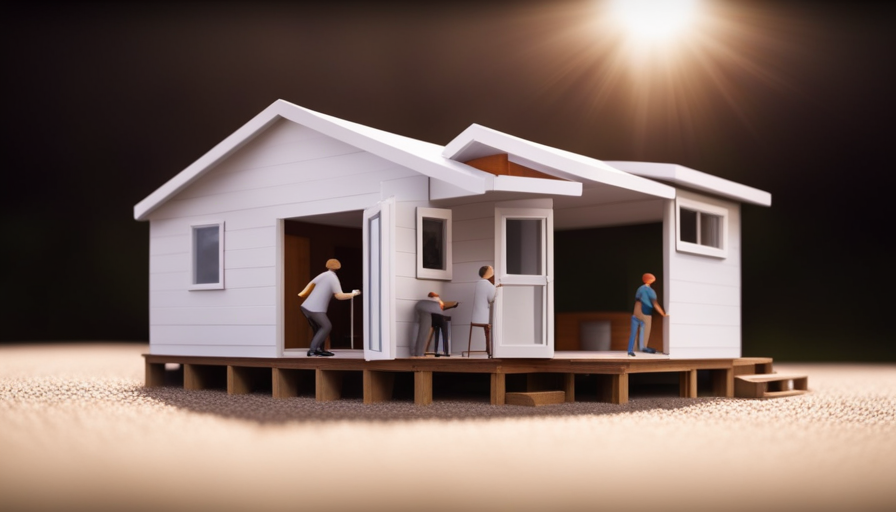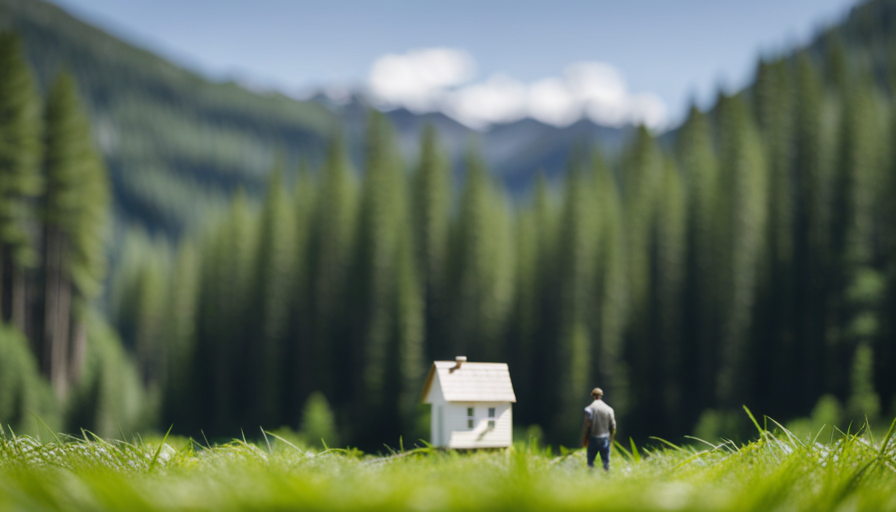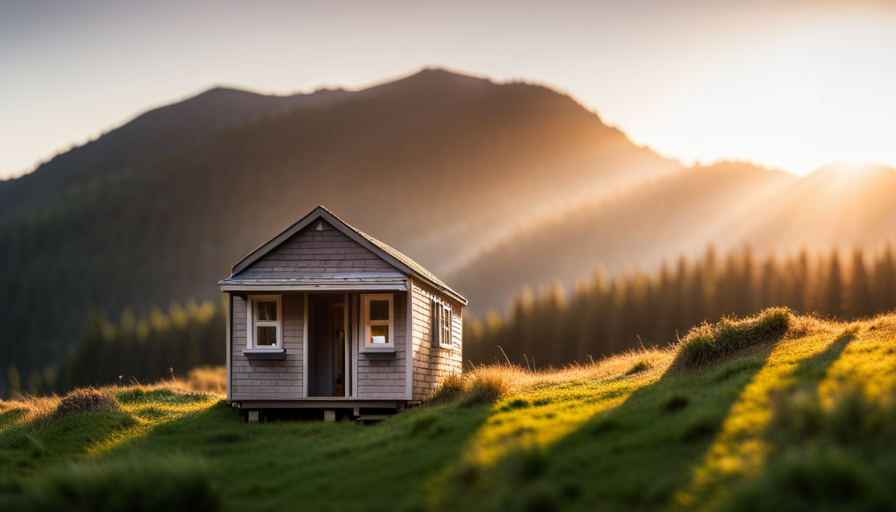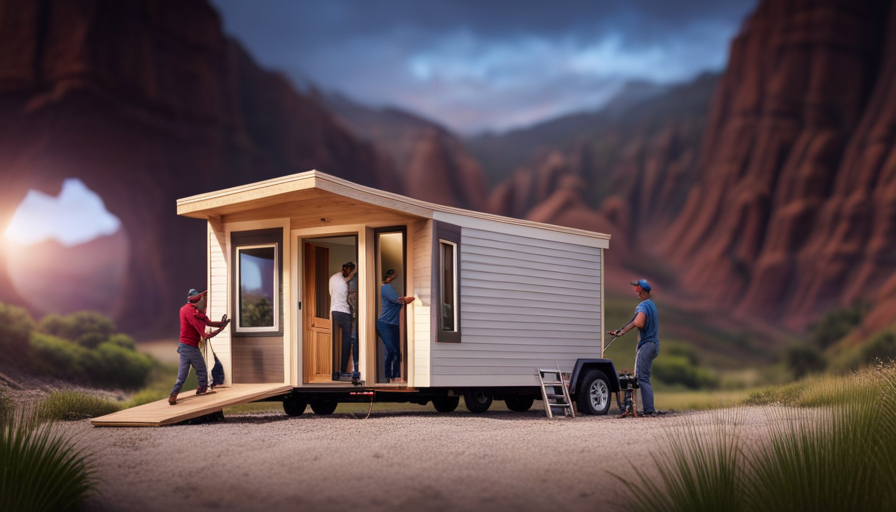Did you know that the average American uses around 80-100 gallons of water per day?
Now, imagine living in a tiny house with limited space and resources. Managing water usage becomes even more crucial when you’re living in a compact environment.
In this article, I will delve into the world of tiny house water consumption and explore various strategies for conserving and managing water in these small dwellings.
From calculating average water consumption to addressing supply challenges, we will cover it all. Additionally, we’ll discuss innovative technologies designed specifically for tiny houses that can help save valuable water resources.
Embracing a minimalist approach to water usage is essential in maximizing efficiency and sustainability within your tiny home.
Furthermore, understanding local regulations and conservation efforts is vital to ensure responsible water usage.
So join me as we dive into the fascinating world of how many gallons of water are needed in a tiny house and discover practical solutions for embracing sustainability in our daily lives.
Key Takeaways
- Calculating average water consumption in a tiny house is crucial for effective management.
- Embracing a minimalist approach to water usage is important in tiny homes.
- Installing water-efficient fixtures and using greywater systems can significantly reduce water consumption.
- Collecting rainwater can help minimize reliance on municipal sources and promote sustainability.
Understanding Your Water Needs in a Tiny House
You’ll be amazed at how much water you actually need in your tiny house! When it comes to calculating water requirements for a tiny home, it’s essential to consider various factors that can affect your water consumption. Managing your water supply effectively is crucial to ensure you always have enough water on hand.
To start calculating your water needs, take into account the number of people living in your tiny house and their daily activities that require water. This includes drinking, cooking, cleaning dishes, personal hygiene, and laundry. Additionally, consider any outdoor activities or gardening that may require additional water usage.
It’s also important to factor in the efficiency of your appliances and fixtures. Low-flow faucets and showerheads can significantly reduce your overall water consumption. Additionally, installing a composting toilet or using greywater systems can help minimize wastewater production.
By accurately calculating average water consumption in tiny homes based on these factors, you can better manage your resources and ensure you have an adequate supply at all times. Understanding how much water you actually need will allow you to make informed decisions when it comes to storage options and conservation methods.
In the next section about calculating average water consumption in tiny homes, we will explore specific steps for determining precise figures without any guesswork involved.
Calculating Average Water Consumption in Tiny Homes
On average, a compact dwelling consumes a moderate volume of water. Calculating water consumption in tiny homes is crucial for estimating water requirements and ensuring an adequate supply. Here are four key factors to consider:
-
Daily Activities: List the activities requiring water in your tiny house, such as showering, doing laundry, washing dishes, and watering plants. Determine the frequency and duration of each activity to estimate their corresponding water usage.
-
Fixture Efficiency: Assess the efficiency of your fixtures like faucets, showers, and toilets. Low-flow fixtures can significantly reduce water consumption without compromising functionality.
-
Water Storage Capacity: Calculate the storage capacity needed based on your estimated daily consumption. Consider rainwater harvesting or installing additional tanks to ensure an uninterrupted supply.
-
Conservation Measures: Implement conservation measures to minimize water wastage in your tiny home. Simple practices like turning off faucets when not in use or collecting graywater for non-potable purposes can make a significant difference.
By accurately calculating average water consumption and estimating your specific requirements, you can effectively manage your resources in a tiny house setting.
In the subsequent section about tips for conserving water in a tiny house, we’ll explore practical strategies to further optimize water usage and promote sustainability without compromising comfort or convenience.
Tips for Conserving Water in a Tiny House
When it comes to conserving water in a tiny house, there are three key points to consider. First, installing water-efficient fixtures can significantly reduce water usage.
Second, implementing greywater systems allows for the reuse of wastewater from sinks and showers for non-potable purposes.
And finally, collecting rainwater for household use provides an additional source of water that is both cost-effective and environmentally friendly.
By incorporating these strategies into a tiny house design, one can effectively minimize water consumption and promote sustainable living.
Installing Water-Efficient Fixtures
To truly transform your tiny house into a water-wise wonderland, consider carefully choosing and cleverly installing cost-effective, conservation-conscious fixtures. Water saving strategies can greatly reduce your water consumption while providing numerous benefits. By installing water-efficient fixtures, you can significantly decrease the amount of water used in your daily activities.
Here are three sub-lists to help you make the right choices:
-
Low-flow showerheads: These fixtures limit the flow of water without sacrificing pressure, allowing you to enjoy a satisfying shower experience while conserving gallons of water.
-
Dual flush toilets: These innovative toilets offer two flushing options – one for solid waste and another for liquid waste. This way, you only use as much water as necessary for each type of waste.
-
Faucet aerators: These small attachments mix air with the flowing water, reducing its overall volume without compromising functionality.
By implementing these efficient fixtures, you can save significant amounts of water and reduce your ecological footprint.
Transitioning into the subsequent section about ‘implementing greywater systems’, we will explore further ways to maximize your sustainable living practices.
Implementing Greywater Systems
By implementing greywater systems, you can turn your humble abode into an eco-friendly oasis, where every drop of water is utilized wisely and sustainably. Greywater filtration plays a crucial role in this process by treating wastewater from sources like sinks, showers, and washing machines. This treated greywater can then be reused for purposes such as irrigation or flushing toilets.
To implement a greywater system, you will need to install a series of filters that remove impurities and contaminants from the water. These filters typically include sediment filters, activated carbon filters, and disinfection units. The filtered water can be stored in tanks or directed to specific areas in your garden through an underground distribution network.
Implementing greywater systems not only reduces water consumption but also minimizes the strain on freshwater resources. It is an excellent way to conserve water while maintaining a sustainable lifestyle.
Transitioning into the subsequent section about collecting rainwater for household use: Another effective method for saving water is by collecting rainwater for household use.
Collecting Rainwater for Household Use
After discussing the implementation of greywater systems, let’s now explore the benefits of collecting rainwater for household use.
Rainwater harvesting offers numerous advantages, such as reducing water consumption from municipal sources and decreasing utility bills. Additionally, it helps conserve natural resources and promotes sustainability.
DIY rainwater collection systems are an affordable and efficient way to harness this valuable resource. By installing gutters, downspouts, and a storage tank or barrel, you can capture rainwater that would otherwise go to waste. This harvested water can then be used for various non-potable purposes like gardening, irrigation, and even flushing toilets.
It’s important to note that proper filtration should be considered if the collected water is intended for drinking or cooking purposes.
Transitioning into our next section about managing water storage in a tiny house, let’s explore effective strategies to ensure an adequate supply of water while maximizing limited space.
Managing Water Storage in a Tiny House
Water storage in a tiny house can be effectively managed with careful planning and the use of compact containers. When it comes to calculating water storage, it’s important to consider the daily water needs of the household. This includes not only drinking water but also water for cooking, cleaning, and personal hygiene.
By optimizing water usage through efficient fixtures and appliances, such as low-flow faucets and showerheads, you can minimize your water consumption.
To store water in a small space, compact containers are essential. There are various options available, including collapsible tanks or portable jugs that can fit under sinks or in tight corners. These containers should be made from food-grade materials to ensure the safety of your stored water.
Additionally, it’s crucial to regularly monitor and maintain your water storage system. This includes checking for leaks or damage to containers and ensuring proper filtration or treatment methods are in place.
By effectively managing your water storage in a tiny house, you can address the challenges of limited space while still meeting your daily water needs. Now let’s explore how we can address other potential challenges related to ensuring a consistent supply of clean water in tiny homes without compromising on space efficiency.
Addressing Water Supply Challenges in Tiny Homes
When it comes to addressing water supply challenges in tiny homes, there are two key points that need to be considered. The first is connecting to a municipal water source, which provides a convenient and reliable water supply for daily needs.
The second point is exploring off-grid water solutions, such as rainwater harvesting or well systems, that can be utilized when a municipal water source is not available or as a backup option.
Connecting to a Municipal Water Source
Although it may seem impossible, connecting to a municipal water source in a tiny house can feel like summoning an ocean of possibilities. By utilizing a municipal water hookup, tiny homeowners have access to a reliable and consistent water supply. This eliminates the need for alternative methods such as rainwater collection or well drilling.
To further understand the benefits of connecting to a municipal water source, let’s take a look at the following table:
| Advantages | Disadvantages |
|---|---|
| Reliable supply | Monthly bills |
| Consistent pressure | Dependence on external system |
| Access to treated water | Limited control over quality |
Connecting to a municipal water source provides numerous advantages but also comes with its own set of disadvantages. Despite these drawbacks, exploring off-grid water solutions becomes essential in order to mitigate reliance on external systems.
[Transition sentence into next section: Exploring off-grid water solutions is crucial for tiny house owners seeking self-sustainability.]Exploring Off-Grid Water Solutions
Imagine the freedom and self-sufficiency you’ll experience as you venture into the realm of off-grid water solutions for your tiny home.
When it comes to off-grid living, one of the most crucial aspects is ensuring a reliable and clean water supply. Off-grid water filtration systems are designed to provide potable water by removing contaminants and impurities from alternative water sources. These systems utilize advanced filtration technologies such as reverse osmosis or activated carbon filters to ensure that the water you consume is safe and free from harmful substances.
By tapping into alternative water sources like rainwater harvesting or well water, you can reduce your reliance on municipal supplies and embrace a more sustainable lifestyle. Transitioning into monitoring water usage in a tiny house allows you to optimize your conservation efforts while maintaining an adequate supply of fresh, clean water.
Monitoring Water Usage in a Tiny House
Monitoring water usage in a tiny house can be as refreshing as taking a cool shower on a hot summer day. Calculating water usage and tracking water consumption are essential tasks for any tiny house owner who wants to live sustainably and efficiently. With limited space and resources, it becomes crucial to understand how much water is being used on a daily basis.
To monitor water usage, I employ various methods and technologies. First, I installed flow meters at key points in the plumbing system to measure the amount of water flowing through different fixtures. This allows me to track specific areas where water might be wasted or used excessively. Additionally, I use smart home devices that connect to my phone, enabling me to remotely monitor my water consumption in real-time.
By monitoring my water usage closely, I am able to make informed decisions about conservation efforts and implement strategies for reducing waste. Whether it’s fixing leaky faucets or adopting more efficient appliances, every drop counts when you’re living in a tiny house.
Transitioning into the subsequent section about innovative water-saving technologies for tiny houses, it’s important to explore further ways we can optimize our water use without compromising comfort or convenience.
Innovative Water-Saving Technologies for Tiny Houses
Transitioning to the realm of water-saving technology, let’s explore some innovative ways to optimize resource usage in compact living spaces. In a tiny house, every drop counts, so it is essential to incorporate water-saving appliances and innovative plumbing systems into the design. These advancements not only help conserve water but also contribute to a more sustainable lifestyle.
One example of a water-saving appliance for tiny houses is a low-flow showerhead. By reducing the flow rate while maintaining adequate pressure, these showerheads can save gallons of water per minute compared to traditional ones. Another option is a dual-flush toilet that offers different flushing options for liquid and solid waste, significantly minimizing unnecessary water usage.
Innovative plumbing systems can further enhance water efficiency in tiny houses. Greywater recycling systems capture and treat wastewater from sinks and showers, making it suitable for non-potable uses like toilet flushing or irrigation. Additionally, tankless hot water heaters provide instant hot water on demand without wasting energy or waiting for the tank to heat up.
By integrating these cutting-edge technologies into the design of a tiny house, individuals can adapt to a minimalist water lifestyle while reducing their environmental footprint. It’s all about finding creative solutions that maximize resource utilization and ensure sustainable living practices without compromising comfort or convenience.
Adapting to a Minimalist Water Lifestyle in a Tiny House
By incorporating innovative water-saving technologies, I can seamlessly adapt to a minimalist lifestyle in my compact living space, exploring the truth behind theories of reducing resource consumption and embracing sustainability.
Adapting water-saving habits is crucial in ensuring efficient water storage in a tiny house. One way to achieve this is by installing low-flow fixtures such as faucets and showerheads that reduce the flow rate while maintaining adequate pressure. Additionally, using dual-flush toilets can significantly minimize water usage by allowing for different flush options based on solid or liquid waste.
Another essential aspect of adapting to a minimalist water lifestyle is implementing rainwater harvesting systems. These systems collect rainwater from the roof of the tiny house and store it for later use in household activities such as flushing toilets or watering plants. Installing greywater recycling systems further enhances efficiency by treating wastewater from sinks and showers for non-potable purposes like irrigation.
Educating yourself on local water regulations and conservation efforts is crucial for effective management of resources in a tiny house. Understanding these regulations will enable me to make informed decisions about water usage and conservation methods specific to my area. It also helps me stay updated on any incentives or rebates available for implementing sustainable practices.
By adopting these innovative technologies and adapting my habits, I can maximize efficiency and minimize wastage in terms of water consumption within my tiny house, paving the way towards a more sustainable future without compromising comfort or convenience.
Educating Yourself on Local Water Regulations and Conservation Efforts
When it comes to living in a tiny house, understanding local water usage restrictions is crucial. By educating myself on these regulations, I can ensure that I’m using water responsibly and within the legal limits.
Additionally, supporting water conservation initiatives not only benefits the environment but also helps me reduce my own water consumption and contribute to the overall sustainability of my lifestyle.
Understanding Water Usage Restrictions
Curious about water usage restrictions? Wondering how many gallons of water your tiny house can hold? Let’s dive in and explore the fascinating world of water conservation!
When it comes to calculating water usage, it’s crucial to consider the various appliances and fixtures in your tiny house. Each one has its own specific flow rate, which determines how much water it uses per minute. By adding up these individual rates, you can estimate your total daily water consumption.
To conserve water, there are several techniques you can implement, such as installing low-flow faucets and toilets, fixing leaks promptly, and collecting rainwater for non-potable uses like gardening. These practices not only help reduce your environmental impact but also save you money on utility bills.
Transitioning into supporting water conservation initiatives, let’s explore ways we can make a difference in preserving this precious resource.
Supporting Water Conservation Initiatives
Get involved in supporting water conservation initiatives to contribute to the preservation of this invaluable resource. By promoting water conservation and implementing water saving techniques, we can make a significant impact on reducing our water usage.
Here are five ways you can support these initiatives:
-
Install low-flow fixtures such as faucets and showerheads to reduce water consumption.
-
Collect rainwater for gardening or other non-potable uses.
-
Implement greywater systems to reuse water from sinks, showers, and laundry for irrigation.
-
Fix any leaks promptly to prevent wasted gallons of water.
-
Educate others about the importance of conserving water and encourage them to adopt sustainable practices.
Embracing sustainability in tiny house water usage is crucial for minimizing our environmental footprint.
Conclusion: Embracing Sustainability in Tiny House Water Usage
To sum it up, embracing sustainability in a tiny house means being mindful of your water usage and finding creative ways to conserve every precious gallon. Embracing sustainable practices is crucial in reducing water waste and minimizing our environmental impact.
One way to achieve this is by installing low-flow fixtures such as faucets, showerheads, and toilets. These fixtures are designed to use less water without compromising functionality. Additionally, using aerators on faucets can further reduce water consumption by adding air to the water stream.
Collecting rainwater is another effective method for conserving water in a tiny house. By installing rain barrels or cisterns, you can capture rainfall from your roof and use it for various purposes such as watering plants or flushing toilets. This not only reduces reliance on municipal water sources but also helps prevent stormwater runoff.
Furthermore, repairing leaks promptly is essential in preventing unnecessary water wastage. Even a small leak can result in significant water loss over time. Regularly inspecting your plumbing system and promptly addressing any leaks will help conserve this valuable resource.
Embracing sustainability in a tiny house requires adopting practices that prioritize reducing water waste. By incorporating low-flow fixtures, collecting rainwater, and addressing leaks promptly, we can significantly minimize our ecological footprint while still enjoying the comforts of home.
Frequently Asked Questions
How much does it cost to install a water storage system in a tiny house?
Installing a water storage system in a tiny house can be quite affordable. When comparing costs, it’s important to consider the various water storage options available.
These options range from simple rainwater collection systems to more advanced filtration and purification systems. Depending on your needs and budget, prices can vary.
It’s always wise to research different suppliers and consult with professionals to find the best option that meets both your water requirements and financial constraints.
Are there any government incentives or grants available for implementing water-saving technologies in a tiny house?
Yes, there are government incentives and grants available for implementing water-saving technologies in a tiny house. These incentives and grants aim to promote the use of efficient water systems that reduce water consumption. By incorporating water-saving technologies such as low-flow fixtures, rainwater harvesting systems, and greywater recycling systems, homeowners can qualify for financial assistance from the government. These incentives encourage sustainable practices and help reduce overall water usage in tiny houses.
Can I use rainwater for drinking and cooking purposes in a tiny house?
Can rainwater be used for drinking and cooking in a tiny house? Yes, it can. While it may seem like an eco-friendly option, there are both pros and cons to consider. Rainwater can be filtered and treated for safe consumption using a combination of physical, chemical, and biological methods. However, it’s important to note that rainwater may contain contaminants such as bacteria, chemicals, or pollutants. Therefore, proper filtration and treatment systems must be in place to ensure its safety.
Are there any specific water regulations or restrictions that apply to tiny houses in certain areas?
There may be specific water regulations or restrictions that apply to tiny houses in certain areas. These regulations can vary depending on local laws and ordinances. It is important for tiny house dwellers to research and understand these regulations before setting up their water systems.
Water conservation methods, such as using low-flow fixtures and collecting rainwater, can help minimize water usage in a tiny house. Additionally, installing efficient water filtration systems ensures the quality of the water used in cooking and drinking purposes.
What are some common challenges in managing and maintaining a water supply in a tiny house?
Managing and maintaining a water supply in a tiny house presents several challenges. One of the main difficulties is managing water usage efficiently due to limited storage capacity.
Additionally, finding suitable water sources can be challenging, especially in remote areas or regions with strict regulations. Therefore, it’s crucial to implement conservation methods such as installing low-flow fixtures and rainwater harvesting systems to maximize available resources and minimize reliance on external water sources.
Conclusion
In conclusion, as I reflect on the intricate dance between water and life in a tiny house, I’m reminded of the profound symbolism it holds.
Water, like our dreams, is a precious resource that must be cherished and conserved.
By embracing sustainability in our water usage, we not only ensure our own survival but also honor the interconnected web of existence.
Let us become guardians of this vital element, weaving a tapestry of resilience and mindful stewardship for generations to come.
Hi, I’m Emma. I’m the Editor in Chief of Tiny House 43, a blog all about tiny houses. While tree houses are often associated with childhood, they can be the perfect adult retreat. They offer a cozy space to relax and unwind, surrounded by nature. And since they’re typically built on stilts or raised platforms, they offer stunning views that traditional homes simply can’t match. If you’re looking for a unique and romantic getaway, a tree house tiny house might just be the perfect option.
